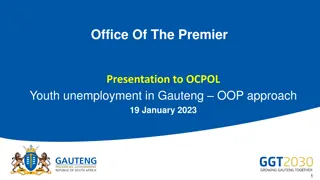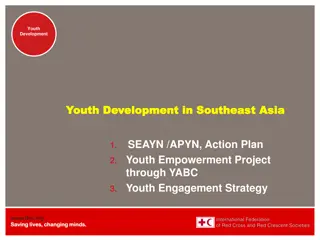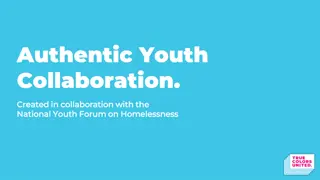Understanding and Supporting 2SLGBTQQIA+ Youth in the Workplace
This resource provides key terms and concepts to support 2SLGBTQQIA+ youth in the workplace, including definitions of sexual orientation, gender identity, transitioning, and more. It aims to help employers create inclusive and supportive environments for all employees, regardless of their sexual orientation and gender identity.
Download Presentation

Please find below an Image/Link to download the presentation.
The content on the website is provided AS IS for your information and personal use only. It may not be sold, licensed, or shared on other websites without obtaining consent from the author. Download presentation by click this link. If you encounter any issues during the download, it is possible that the publisher has removed the file from their server.
E N D
Presentation Transcript
Working With Youth That Identify as 2SLGBTQQIA+: Employer Resources How to help support youth in the workplace
Working With Youth That Identify as 2SLGBTQQIA+ Key terms to consider: 2SLGBTQQIA+: Two-spirit, Lesbian, Gay, Bisexual, Transgender, Queer, Questioning, Intersexed, and Asexual. Sexual orientation: Related to who an individual is attracted to and who they feel drawn to romantically, emotionally, and sexually. Heterosexual/straight: An individual that is romantically, emotionally, and sexually attracted to people of the opposite sex. Queer: An umbrella term that embraces all sexual preferences, orientations, and gender identities that are outside of the heterosexual and/or monogamous majority. Queer includes but is not limited to lesbians, gay men, bisexuals, transgender individuals, intersex persons, etc. This term has become a reclaimed word for the 2SLGBTQ+ community as it was formerly used as a derogatory word to describe individuals that identified as gay or lesbian. As such, individuals that are not a part of the 2SLGBTQ+ community are discouraged from using the term.
Terms Continued... Sex: Recognized as a medical term that is used to subdivide individuals into the male and female category. Gender identity: An individual s innermost concept of self as male, female, a blend of both, or neither how the individual perceives themselves and what they call themselves. Gender identity can be the same or different from one's sex assigned at birth. Transgender: An individual whose gender identity differs from the sex they were assigned at birth. Sexual orientation varies and is not dependent on gender identity. Transitioning: The process that an individual goes through to change their gender presentation and/or sex characteristics to accord with their internal sense of gender identity.
Terms Continued Cisgender: A term that is used to describe someone whose gender identity aligns with the sex that is assigned to them at birth. Gender expression: The external appearance of a person s gender identity, usually expressed through behaviour, clothing, haircut, or voice, and which may or may not conform to socially defined masculine or feminine behaviours and characteristics. Binary: The gender binary is a system of viewing gender as solely consisting of two identities and sexes man and women or male and female. Non-binary: An individual that does not identify within traditional categories of male and female. Non-binary directly references the gender binary, or the idea that there are only two categories of gender experience.
Terms Continued Gender fluid: An individual that does not identify with a single fixed gender, and expresses a fluid or unfixed gender identity. The individual s expression of identity is likely to shift and change depending on context. Gender non-conforming: Individuals who exhibit behavioural, cultural, psychological traits or gender expressions that don t conform to traditional gender norms. Gender questioning: An individual that is questioning their own sexual orientation, sexual identity, gender, or all three and is a process of exploration where individuals may be unsure, still exploring, or are concerned about applying a social label to themselves. Mis-gender: Individuals that use the wrong pronouns or other gender-specific words when referring to or speaking to someone, especially a transgender person.
How Can I Make the Workplace a Safe Space? Ensure that the workplace has non-discriminatory policies implemented, including things about sexual orientation, gender identity, and gender expression. Employers should display these policies prominently in a visible area that all employees will have access to, in addition to speaking about these topics during a mandatory training. There should also be a clear outline of the action that will be taken if an employee has experienced discrimination in the workplace. Educate yourself about topics in relation to the 2SLGBTQ+ community. Model acceptance and inclusion in the workplace (demonstrate what is acceptable in the workplace). Speak up against homophobia, transphobia, and sexism.
Identifying Homophobic and Transphobic Language and Behaviours: What is homophobic language? Most of the time homophobic language is used unconsciously and without hurtful intent. However, it is still important to recognize and address it so that individuals are educated about why it is inappropriate to be using this language. This can help ensure that they aren t continuing to use hurtful and derogatory language that is directed at the 2SLGBTQ+ community. Examples: That s so gay or You re so gay These comments are most often used to mean that something is bad, stupid, or worthless, with no conscious link to sexual orientation at all. No homo Individuals usually use this expression after they have said something they worry might be perceived as being gay to make it is clear that they are not gay. Homophobic insults and terms This includes words like queer , poof , fag , faggot , and dyke . These abusive terms aren t only used towards individuals that identify with the 2SLGBTQ+ community, but are often directed at individuals that are thought to be gay or in other ways that are gender non-conforming.
Personal Pronouns Gender identities and gender expression is ever-changing and is more than the general binary of either male or female. Some individuals identify as both masculine and feminine, or neither. Thus, they may prefer to identify as genderqueer, gender fluid, or non-binary. Individuals that identify as genderqueer, gender fluid, or non-binary may prefer a gender-neutral pronoun, such as they (Ex. Sam came to work very early today. They are very good with their time management ). Pronouns refer to how an individual chooses to identify as- for example, he, him, and his, she, her, and hers, and/or they, them, and theirs or Ms. , Mr. , Mx. Using someone s correct pronouns is important because this is a personal aspect of an individual. We want to show our respect and basic courtesy for the person. The experience of mis-gendering someone can be extremely hurtful, angering, and can create tension not only between the staff, but also with the customers. If you aren t sure of someone s pronouns, ask them! It s always helpful to ask the people that you work with about the pronouns that they want to go by and if they are comfortable with having this shared with the rest of the workplace or if there is another pronoun that they d prefer to go by in front of their colleagues.
Personal Pronouns Continued Offering personal pronouns as part of introduction processes at the start of meetings or events (ex. We re going to go around the room and introduce ourselves. Please state your name, the department you work in, and if you are comfortable, your personal pronouns ). This way you re giving a choice for the individual to decide whether they want to disclose their preferred pronouns or not, so they won t be put into an uncomfortable situation. Role model appropriate pronoun use when introducing the individual to other staff (if they ve given you consent to use their preferred pronoun and name). This makes a significant difference in how other staff in the workplace will follow.
Using the Correct Pronouns in the Workplace Think of ways to allow employees to have the option to articulate their preferred name and pronoun, and to have it be articulated in all settings (formal and informal- ex. email, in-person meetings, business cards, name badges, etc.) Opportunities to ask/offer pronouns: Interview process share your own pronoun, it encourages and creates a comfortable environment for others to also share their pronoun. Ask the individual what they would want you, the employer, to refer to them as (pronouns and name) and if it is the same pronoun that they are comfortable with you using to refer to them in front of the other staff. Although individuals may state their preferred pronouns with you, they may not necessarily feel comfortable or the same about sharing their preferred pronouns or name with colleagues or other individuals in the workplace, thus it is important to always ask what they are most comfortable with.
Accommodation of Restrooms Gender inclusive washrooms are toilet facilities that can be used by someone of any gender. All-gender facilities can be single-use or multi-stall. Why are gender-inclusive washrooms important? For individuals who are nonconforming, identify as transgender, gender queer, or gender fluid, using a public washroom that is for a specific gender can be an extreme source of anxiety and stress. Individuals that do not conform to what is commonly expected for men and women, can frequently be subjected to staring, questions, comments, possible verbal harassment, and/or physical violence when trying to access the washroom.
What Are the Best Practices for Instituting Gender-Inclusive Washrooms? Educate your employees (why the workplace has gender-inclusive washrooms). Start the transitioning process slowly (it is not necessary to convert every washroom in the workplace to be gender-inclusive initially, however, employers should identify washrooms that are convenient and accessible to convert first, or build new washrooms that are gender-inclusive). Install single-toilet all-gender bathrooms with doors that lock. Don t police which washroom employees use (employees should be able to access and utilize facilities that they are comfortable using and that corresponds to their gender identity). Recognize that the use of an all-gender washroom is a matter of personal choice and employees should not have to endure the added harassment and judgment when using gender-specific facilities.
Dress Codes/Uniform Priority Dress codes should be modified to avoid gender stereotypes and should apply consistently to all employees. Allow employees to dress consistently in accordance to their gender identity. If there are dress codes implemented in the workplace, particularly if there are different rules for men and women, ensure that the rules aren t reinforcing gender stereotypes or putting individuals in a position where they are objectified. It is better to avoid gender-based policies in terms of dress codes because of the potential for discrimination.
What Can Training Consist of? Training ideas: Employers can choose to train their staff about 2SLGBTQ+ topics and issues in a general training of equality and diversity training. Although this training may only be a broad overview of the topic, it still sends a clear message that any discriminatory acts against a staff s sexual orientation or gender identity is not tolerated and is putting emphasis on the importance of 2SLGBTQ+ conversations in training and the workplace. The best training will encourage staff to critically reflect on their own biases and how it may influence their behaviour. This encourages staff to modify any behaviour that can discriminate against individuals of the 2SLGBTQ+ community. o RESOURCE: The Safe Zone Project (Free + Online; 2SLGBTQ+ awareness and ally training workshops) Teaches topics about LGBTQ+ topics (identities, gender and sexuality, and examining prejudice, assumptions, and privilege). Training is the first step in showing your dedication and want in creating a LGBTQ+ inclusive space/environment.
What to Include in Training: The organization s policy on homophobic and transphobic harassment and discrimination. How employees can report instances of discrimination, bullying, or harassment in regards to homophobic and transphobic behaviour. Resources that staff can access for further information and support. Meanings and definitions of certain terms and 2SLGBTQ+ language (ex. using the appropriate and preferred pronouns). The negative impact of perpetuating stereotypes about the 2SLGBTQ+ community in the workplace. Identifying homophobic and transphobic language and behaviour. Ways to challenge inappropriate behaviour in work settings.
Approaching Situations Where the Youth Feels Uncomfortable or Is Being Harassed in the Workplace: Be aware of what your 2SLGBTQ+ staff may be dealing with at work, since discrimination in the workplace often takes place in the form of micro-aggressions, such as passing remarks and comments as jokes. These are usually dismissed and not taken seriously but are actually derogatory and can contribute to a hostile work environment. If employers keep silent during these situations, it can pass as a form of acceptance or agreement of the harmful behaviours. In situations where an employee is discriminated against due to their gender identity and/or sexual orientation, it is important to check in with the person who may have been harmed. Employers should directly intervene and explain why that behaviour is unacceptable. This way you re showing your support for the staff that may not feel safe or comfortable to speak up. Make it clear about the sort of behaviour that is expected of your staff team and help your organization put the policies into practice. This may also help staff know what to do if they are experiencing homophobia, biphobia, transphobia, etc. in the workplace.
Considerations to Recognize When Having Critical Conversations: There are workplace standards that are expected to follow, however it is also important to let employees know that you are not asking them to change their personal values/beliefs, more so that employees need to be courteous and respectful to each other. During the trainings, employers should bring about topics of stereotype and stigma, so that it can start conversations and create that open space for individuals to share their fears and concerns and address any stigmas or stereotypes. Emphasizing during the training that 2SLGBTQ+ is beyond simply the attraction that an individual has for specific individuals that it is more about the individual s identity, and giving the individual space to authentically be who they are, so that they re comfortable in the workplace to be able to express themselves freely and openly.
Any Questions, We Are Here to Help: As always, the Employment Programs team at 360 kids are happy to support/guide and educate you further on any of the covered topics. Please see below contact information: Courtney Cot, STEP Counsellor: 647-637-6023 Courtney.cot@360kids.ca Niloufar Barari, STEP Counsellor: 416-573-8386 Niloufar.Barari@360kids.ca Nirubha Shanmuganathan, Team Lead of Employment Programs: 416-571-1696 Nirubha.Shan@360kids.ca Pamela Sertl, Manager of Employment Programs: 416-574-3047 Pamela.Sertl@360kids.ca























